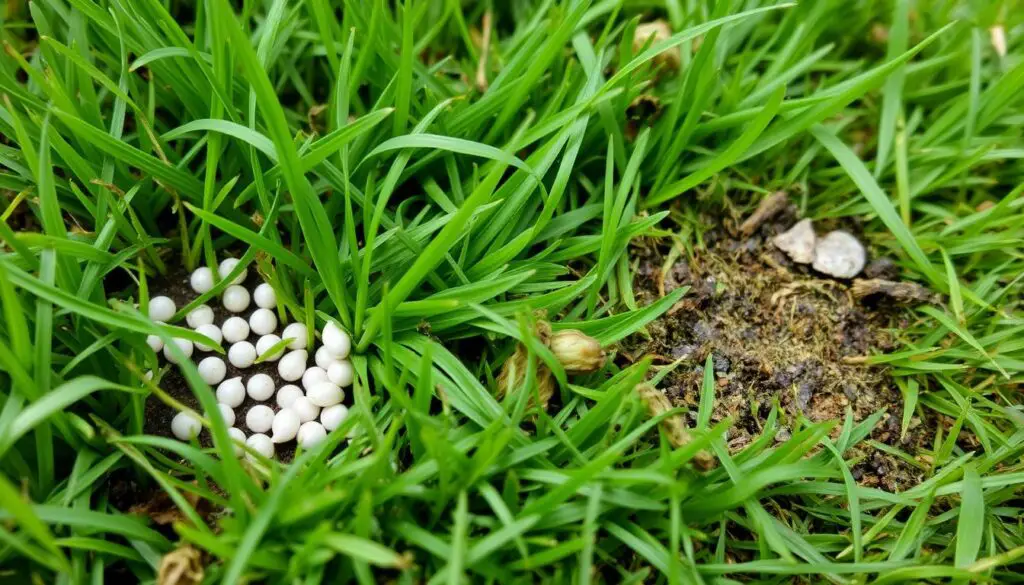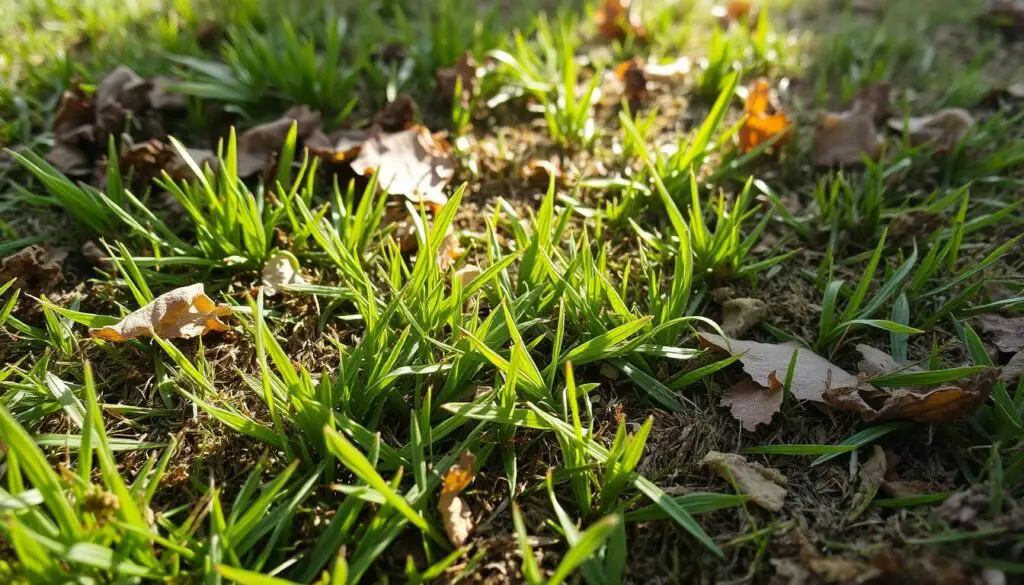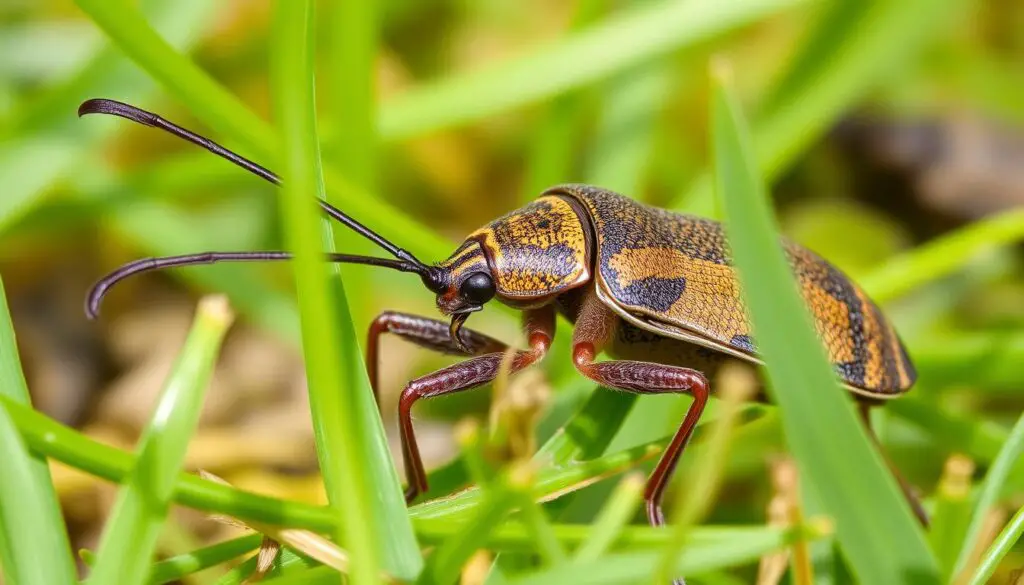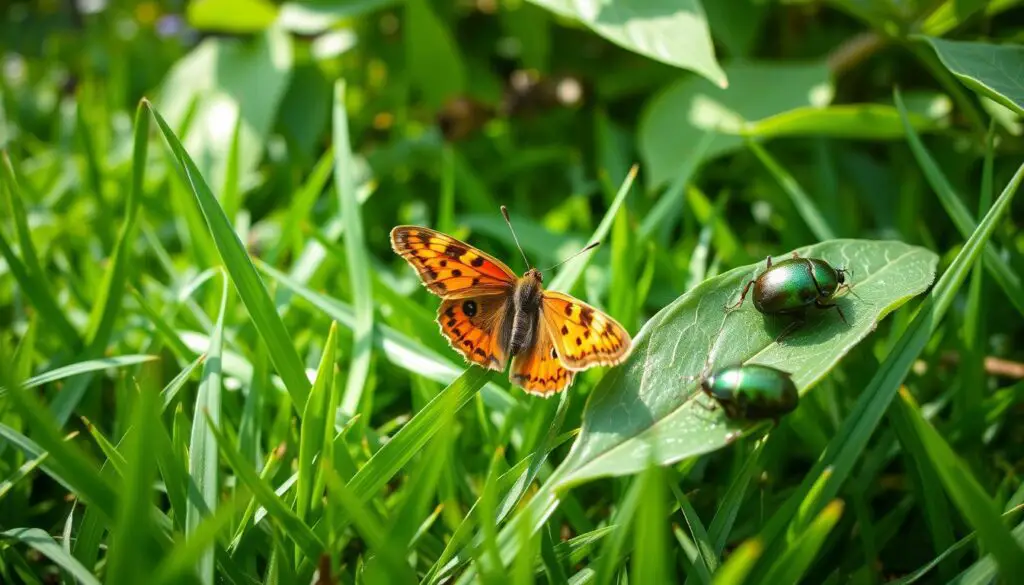How to Identify Common Lawn Pests and Their Solutions

Did you know 20 common lawn pests are discussed in this guide? These pests, like armyworms and Japanese beetles, can harm your lawn. It’s important to know the signs of infestations and how to solve them. This article will help you understand and fight against these pests.
Key Takeaways
- Identify common lawn-damaging insects, such as armyworms, chinch bugs, sod webworms, and cutworms
- Understand the life cycles and signs of grub infestations to tackle them effectively
- Discover effective control methods for pests like billbugs, fiery skippers, and Japanese beetles
- Learn about burrowing pests like mole crickets and their impact on your lawn
- Explore safe, organic solutions to combat lawn pests and maintain a lush, vibrant landscape
What are Lawn Pests?
Lawn pests are a wide range of insects and other organisms that harm your grass. They eat the roots, stems, and leaves of your grass. This can make your lawn look bad and even kill it. Knowing which pests you have is key, as each needs its own treatment.
Common Lawn-Damaging Insects
Some common pests include grubs, chinch bugs, sod webworms, armyworms, and cutworms. These insects can seriously damage your lawn. They can make your grass wilt, turn color, or even die.
Signs of Pest Infestations
Signs of pests might be birds or skunks looking for food, or you see insects moving around. Also, if your grass looks wilted, discolored, or dying, it could mean pests are present.
To keep your lawn pest-free, it’s important to know about these pests. By being quick to act and understanding their habits, you can keep your lawn healthy and pest-free.
“Maintaining a healthy lawn is the best defense against pests, as pest resistance can vary between different grass types.”
Identifying Grubs
Grubs are a common and damaging pest in lawns. They are the larval stage of various beetles. These plump, C-shaped larvae eat grass roots, harming the plant’s health. Knowing how to identify grubs is key for good lawn care and pest control.
Types of Grubs
Many grub species can harm lawns. White grubs, from masked chafers and Japanese beetles, are common. They grow from half an inch to two inches long. Other types include May beetles, June beetles, and Asiatic garden beetles.
- White grubs have a C-shaped body, a brown head, and six legs.
- May beetle grubs are larger, up to two inches long, with a dark brown head.
- Asiatic garden beetle grubs are smaller, around one-half inch, with a reddish-brown head.
Grub Life Cycle
Knowing the grub life cycle helps with control. Adult beetles lay eggs in midsummer. These eggs hatch into larvae in late summer. The grubs then feed through fall and spring before pupating and becoming adult beetles in late spring or early summer. Monitoring for grub activity and applying treatments in late spring or early summer can protect your lawn.
| Grub Life Cycle Stages | Timing |
|---|---|
| Egg-laying by adult beetles | Midsummer |
| Egg hatching into larvae (grubs) | Late summer |
| Grub feeding and growth | Fall and spring |
| Pupation and emergence of adult beetles | Late spring or early summer |
Understanding grub types and their life cycle helps homeowners fight these pests. This knowledge is crucial for a healthy, lush lawn.

lawn pests
Armyworms
Armyworms are a major problem for lawns. They are 1- to 2-inches long and come in colors like gray, yellow, and pink. They eat grass blades and stems, leaving behind circular bare spots.
These pests are most active at night and in the evenings. They go through two to three generations in the spring and summer. Adult moths have furry abdomens.
To spot an armyworm problem, look for the caterpillars and the damage they cause. Armyworm damage can spread fast. It’s crucial to act quickly to stop them.
“Armyworms destroy everything in their path and invade lawns in large numbers.”
- Keep an eye on your lawn for armyworm signs, more so in spring and fall.
- Use insecticides as directed to kill armyworms.
- Keep your lawn healthy to fight off armyworm damage and recover faster.
By watching closely and acting fast, you can save your lawn from armyworms. This way, your grass stays green and healthy.
Chinch Bugs
Chinch bugs are a common pest that can harm your lawn. They suck sap from grasses like bentgrass and Kentucky bluegrass. Chinch bugs have been in the U.S. since the 18th. They love hot, dry weather in mid-summer.
When chinch bugs feed, they stop grass from getting water. This causes the grass to wilt and die. They lay eggs in spring and summer, with many generations in warmer months. In fall, they hide at grass stem bases.
To spot chinch bugs, look for yellow grass near warm spots. Adult chinch bugs can lay up to 300 eggs in 40 to 50 days. They like red fescues and perennial ryegrass.
| Chinch Bug Facts | Statistics |
|---|---|
| Chinch bug population threshold | 15 to 20 insects per square foot |
| Chinch bug life stages warranting control | 20 to 30 per square foot |
| Chinch bug population in Pennsylvania lawns | 150 to 200 insects per square foot |
To stop chinch bugs, keep your lawn healthy. Mow, fertilize, aerate, and water regularly. Use endophyte-enhanced seed and attract natural predators like big-eyed bugs.
While chinch bugs are tough to beat, early action can save your lawn. Knowing their habits helps you protect your green space.
Sod Webworms and Their Damage
Sod webworms are a big problem for many homeowners. These caterpillars, the young of sod webworm moths, can harm your grass. They leave brown patches and silken burrows behind. Knowing how sod webworms live is key to controlling them.
Sod Webworm Life Cycle
The life of a sod webworm lasts about a year. Female moths can lay up to 200 eggs in early summer. These eggs hatch into larvae after 10 days.
These larvae go through six to 10 stages, eating grass until late September. Then, they start to overwinter.
Adult moths come out after 10 to 14 days of pupation. The cycle starts again. It’s the larvae that really harm your lawn, more so in dry times.
“Larval populations can pose real distress to a lawn. Sod webworms that hatch in early spring cause the most damage.”
Signs of sod webworms include small brown spots on grass. These spots can grow into big, ugly patches. Watching your lawn and acting fast when you see these signs is crucial for a healthy lawn.

There are many ways to fight sod webworms, like using nematodes or insecticides. By knowing their life cycle and taking action, you can keep your lawn looking great.
Cutworms in Your Lawn
Cutworms are a common pest that can harm your lawn. They are gray or brown, 2-5 cm long, and eat grass at the base. This can lead to dead patches in your lawn. They can have up to six generations a year in the southeastern U.S.
The female moths lay eggs on grass in spring. The eggs hatch in 3-10 days. Then, the larvae grow for 20-45 days before turning into pupae for two weeks. During this time, they can burrow into the thatch or ground, eating grass at night.
In North Carolina, you’ll find several types of cutworms on turfgrass. These include the black cutworm, bronzed cutworm, granulate cutworm, and variegated cutworm. If you see 2-6 larvae per square yard, you might need to use insecticides.
To control cutworms, use liquid insecticides like acephate or bifenthrin. Apply them in the evening for best results. Also, treat a 20-30 foot area around greens and tees to stop cutworms from spreading.
To keep your lawn healthy, water, mow, and aerate it properly. This can help prevent cutworm infestations. Early action and a complete approach are essential for a thriving lawn.
Billbug Identification
As a lawn enthusiast, I know the frustration of dealing with pesky lawn pests. The billbug is a common culprit that can harm your grass. With a keen eye and some helpful information, you can identify these pests and fix your yard.
Billbugs are mature insects that can grow up to 1/2 inch in length. They have hard shells that range in color from clay-brown to near black. These weevils thrive in many climates and are common pests in North America.
Billbugs typically spawn one generation a year. Their grubs hatch about one to three weeks after the eggs are laid. While they can harm grass, they are harmless to pets and people.
Billbug damage can be mistaken for disease or drought. Dead spots in the grass that don’t “green up” after watering are a sign of billbug damage. Effective treatment can protect your lawn for up to three months.
There are several insecticide options available, such as Sevin® Insect Killer Granules and Sevin® Insect Killer Concentrate. Good lawn maintenance practices can also help prevent billbug problems.

If you suspect a billbug infestation, consult a lawn care professional or your local extension office. They can offer a free lawn analysis and expert advice. By identifying and addressing billbug issues early, you can keep your lawn healthy for years.
Other Common Lawn Pests
While grubs, armyworms, and chinch bugs get a lot of attention, other pests can harm your lawn too. Fiery skippers and Japanese beetles are two examples. They can cause a lot of damage if not stopped early.
Fiery Skippers
Fiery skippers are caterpillars that eat grass, leaving brown patches. They are small and orange. Catching them early is key to keeping your lawn healthy.
Japanese Beetles
Japanese beetles are pests in both their grub and adult forms. Grubs eat grass roots, weakening the lawn. Adult beetles eat the leaves, harming your lawn’s health and look.
Knowing how to identify pests like fiery skippers and Japanese beetles is the first step. Understanding their habits helps you fight infestations. This way, you can keep your lawn looking great.

“Identifying these and other lesser-known lawn pests is crucial for developing a comprehensive pest management plan.”
Mole Crickets and Their Tunnels
Mole crickets live most of their lives underground. They use their strong front legs to dig through the soil. When they come up, they eat grass, causing more damage.
These pests are brown and about an inch long. They have a lobster-like head. They are most active in spring and summer, when they lay eggs.
Mole crickets can cause a lot of damage, costing millions of dollars in some states. In Florida, the damage is in the hundreds of millions. Female mole crickets lay 100 to 150 eggs in moist soil.
The eggs hatch in 10 to 40 days. The young mole crickets stay in the soil all winter. Most adults can fly, making them hard to catch.
It’s important to watch for mole crickets all year, but most in spring. The young ones are most vulnerable in late spring and early summer. Treating them in spring can help stop damage.
For effective control, pesticides need to reach deep into their tunnels. This is key to stopping their damage.
| Mole Cricket Species | Characteristics |
|---|---|
| Tawny Mole Cricket (Neoscapteriscus vicinus) | Considered the most destructive to home lawns, feeding almost exclusively on turfgrass roots and shoots. |
| Southern Mole Cricket (Neoscapteriscus borellii) | Found in the sandy coastal regions of South Carolina. |
| Northern Mole Cricket (Neocurtilla hexadactyla) | Also present in the sandy coastal regions of South Carolina. |
To manage mole crickets, you need to watch for them and take care of your lawn. This includes keeping the soil healthy, mowing right, and watering correctly. The best time to use insecticides is in June and July, when the damage is less and the crickets are smaller.
Greenbugs or Aphids
Greenbugs, also known as aphids, are common pests in lawns. They don’t directly harm the grass but can bother pets and people. Knowing how to spot these greenbugs is key to controlling them.
Identifying Greenbugs
Greenbugs are small, green insects found on grass blades and lawn bases. They belong to the aphid family, with over 4,000 species worldwide. They feed on grass sap, causing discoloration and unhealthy patches.
- Greenbugs are common in small grains and sorghum, and also affect Kentucky bluegrass in the Midwest.
- A single female greenbug can have 1 to 8 offspring daily for 2 to 3 weeks.
- Young aphids mature in 6 to 10 days and start reproducing without mating.
- From 12 to 20 generations of greenbugs can occur each season, depending on the environment.
To spot a greenbug infestation, pull grass blades from discolored areas. Look for tiny light green aphids on the upper blade surface. Large infestations can have thousands of greenbugs per square foot.
“Greenbugs can be present in large numbers, with up to 30 or more aphids per blade and several thousand aphids per square foot of turf.”
Natural controls include predators like lady beetles and weather like rain storms. But when these aren’t enough, chemical control might be needed.
Controlling Lawn Pests Effectively
Managing lawn pests well means using a mix of steps. First, you need to know what pests you have and when they are most active. Then, you can choose between chemical or organic solutions. For some pests, insecticides with pyrethrins or neem oil work well.
But, it’s also smart to try natural methods. These include attracting good bugs, improving soil, and changing how you mow and water. These steps help your lawn stay healthy and pest-free.
Understanding pest life cycles is key. An integrated pest management (IPM) plan helps keep your lawn in top shape all year. IPM uses a mix of methods to prevent pests, not just treat them.
Keeping an eye on your lawn and making changes as needed is crucial. This way, you can stop pests like grubs and chinch bugs before they cause harm. Good lawn care, like using the right fertilizer and water, makes your grass stronger against pests.
FAQ
What are the most common lawn pests?
How can I identify grubs in my lawn?
What are the signs of an armyworm infestation?
How can I identify and control chinch bugs in my lawn?
What is the life cycle of sod webworms?
How can I identify and control cutworms in my lawn?
What are the characteristics of billbugs?
What other lawn pests should I be aware of?
How can I effectively control lawn pests?
Source Links
- https://www.gardentech.com/blog/pest-id-and-prevention/how-to-detect-and-treat-common-lawn-pests
- https://www.saferbrand.com/articles/lawn-pests-safer
- https://www.cardinallawns.com/2021/05/identifying-common-lawn-pests/
- https://mygreenmontgomery.org/2023/5-common-lawn-pests-and-how-to-manage-them/
- https://www.cardinallawns.com/2020/05/six-most-common-lawn-pests/
- https://www.grassmasternc.com/lawn-pest-control/
- https://www.jonathangreen.com/resources/how-to-identify-treat-and-prevent-lawn-grubs/?srsltid=AfmBOoqkXaAlbgTj7IIbtlHwlLTnTTmjGhRLLCWxKsps-VR2VSAhrqPi
- https://lawnrxinc.com/telltale-signs-your-lawn-has-grubs
- https://golfcourselawn.store/pages/how-to-identify-common-lawn-pests?srsltid=AfmBOopC2eOyb5Fj-IOGtFNdoUHNMys17drw8Zxs3IyY1P7ATK0lM0iS
- https://lawnlove.com/blog/common-fall-lawn-pests/
- https://www.cardinallawns.com/2023/05/common-lawn-pests/
- https://organicplantcarellc.com/chinch-bugs/
- https://extension.psu.edu/chinch-bugs-in-home-lawns
- https://www.cardinallawns.com/library/lawn-pests/sod-webworms/
- https://www.canr.msu.edu/resources/sod_webworm_tips_for_your_lawn
- https://content.ces.ncsu.edu/cutworm-in-turf
- https://weedman.com/en-ca/resources/lawn-care-library/cutworm-webworm
- https://www.gardentech.com/insects/cutworms
- https://www.orkin.com/pests/beetles/billbugs
- https://www.gardentech.com/insects/billbugs
- https://www.lawnstarter.com/blog/pest-control/billbugs-how-control-lawn-pest/
- https://golfcourselawn.store/pages/how-to-identify-common-lawn-pests?srsltid=AfmBOork8evt5wqFjOztKE37dAMIphpLiXKPpZsVmLpODNWC7z69rAY9
- https://www.groundsguys.com/blog/2018/august/what-kind-of-pest-is-killing-your-grass-/
- https://www.amdro.com/learn/lawn-pests/protecting-your-turf-against-mole-crickets
- https://hgic.clemson.edu/factsheet/mole-cricket-management-in-turfgrass/
- https://entomology.unl.edu/turfent/documnts/greenbug.shtml
- https://yardandgarden.extension.iastate.edu/article/1992/7-15-1992/aphid.html
- https://extension.umn.edu/yard-and-garden-insects/aphids
- https://nexgreen.com/dealing-with-common-lawn-grubs-prevention-and-treatment/
- https://lawnlove.com/blog/integrated-pest-management-lawn/
- https://bioprotectionportal.com/resources/lawn-pest-control-solutions/

